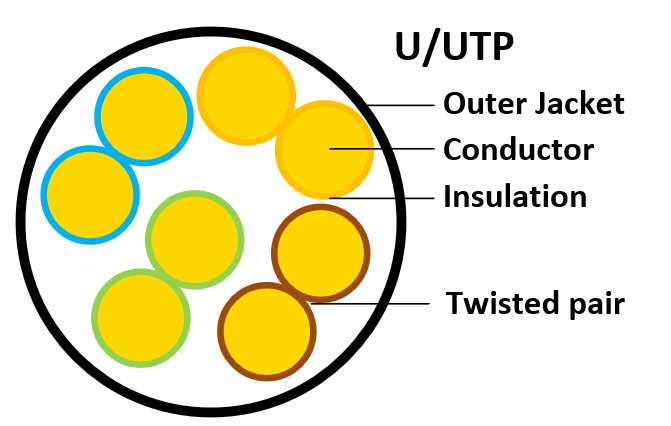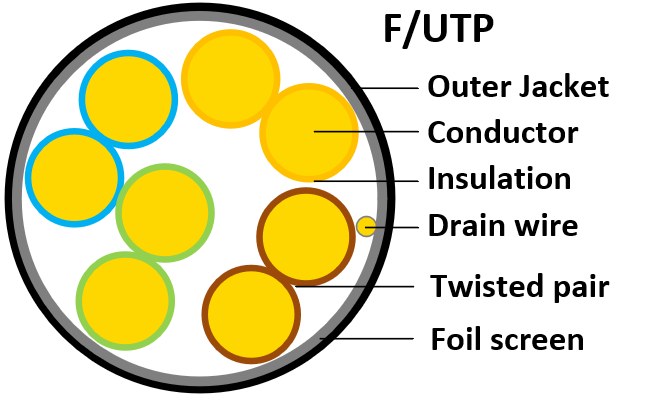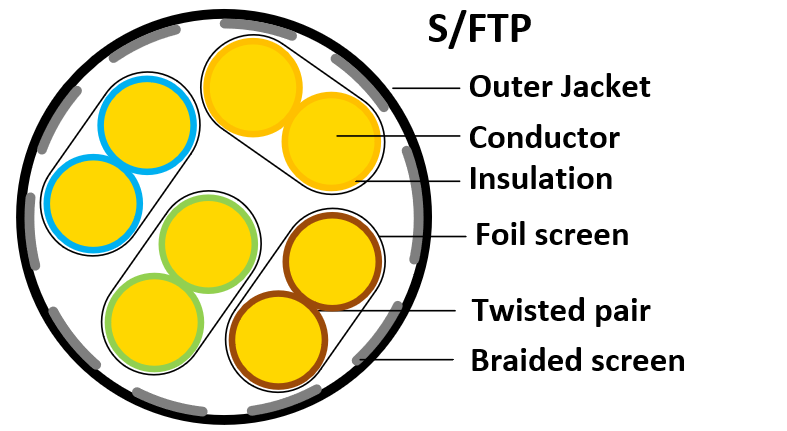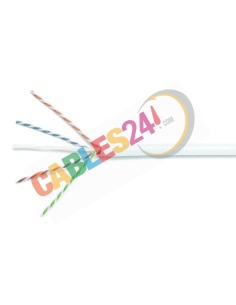- 1606 views
- 0 comments
Ethernet patch cables, used for connecting devices in networks, can come with different types of shielding to protect signals from electromagnetic interference (EMI) and radiofrequency interference (RFI).
It is important to choose the correct Ethernet cable, and to be able to identify it at the job site, especially since there are different types of shielding that might be specified for the installation, depending on the environment.
A code is used to describe the shielding. For example, a completely unshielded Ethernet cable carries the code, U/UTP. Here the first occurrence of “U” before the slash stands for “unshielded.” This means that there is no Foil Shield (F) or braided screen (S) surrounding the entire cable, immediately beneath the jacket. The second occurrence of “U” after the slash also stands for unshielded, but the “TP” after it means that this is referring to individual twisted pairs within the network cable. So “U/UTP” literally stands for “unshielded Ethernet cable / unshielded twisted pairs.”
A shielded network cable might show a code of F/UTP if the overall shield is composed of an aluminum foil. A code of S/FTP means a cable screen of braided aluminum and aluminum foil wraps for each individual twisted pair. “S/FTP” literally stands for “screen-shielded Ethernet cable / foil-shielded twisted pairs.”

Some caution is needed for certain cases. “U/UTP” is often shortened to “UTP,” and “F/UTP” is often shown instead as “FTP.” More often, shielded networking cable is referred to generically as “STP”, regardless of how the cable is shielded. This is a possible point of confusion, especially for those new to the trade.
Below are the most common types of shielding, along with their advantages and disadvantages:
U/UTP (Unshielded/Unshielded Twisted Pair):

This Ethernet cable is completely unshielded. It can be used in situations that lack nearby electromagnetic interference (EMI), and that are not affected by electrostatic discharge (ESD). The lack of shielding allows for the construction of cable that is thinner and more flexible than shielded cable, and so it’s usually easier to install. Unlike shielded Ethernet cable, it does not require a ground connection.
Advantages:
Lower cost.
Greater flexibility.
Disadvantages:
Lower capacity to resist interference in environments with high EMI/RFI.
F/UTP (Foiled Twisted Pair):

This Ethernet cable has an aluminum foil shield (screen) around the entire cable, beneath the jacket. It can help protect data from nearby sources of electromagnetic interference (EMI), and can help dissipate any buildup of electrostatic potential. A small drain wire redirects unwanted noise to ground. This drain wire must be properly grounded, otherwise any benefit from shielding will be lost and the ungrounded screen will actually attract unwanted noise.
Advantages:
Provides an additional level of protection.
Disadvantages:
Lower protection capacity compared to some more advanced types.
S/FTP (Shielded Foiled Twisted Pair):

This Ethernet cable uses an aluminum braided shield (screen) around the entire cable, beneath the jacket. In addition, each individual twisted pair is also wrapped in a foil shield. This construction is designed to minimize crosstalk between pairs in the same cable. Also, the shielded pairs, along with the overall shield provide more protection against external electromagnetic interference than the jacket shield alone.
Advantages:
Higher protection capacity against interference.
Disadvantages:
Less flexible and more expensive than unshielded types.
Choice of shielding type:
The choice depends on the specific requirements of the environment and the performance needed for the network. In environments with high electromagnetic interference, a higher level of shielding is preferred. However, in controlled environments with lower risk of interference, unshielded cables can be used to reduce costs and maintain flexibility.
See all our ethernet cable options in different categories, shielding and colors








Comments (0)